Research
The thing is, it’s impossible to forget the fact I’m a woman. And as a woman, my body doesn’t really belong to me: as an image it has a life of its own. I open my eyes during the day, so I can’t forget that I (and the entire country with me), am constantly consuming images of women, constantly making objects out of and using the bodies of women.
(SLIDE)
In every open magazine, every commercial, window display, movie or reality TV show.
(SLIDE)
The potential to be attacked is down every dark street, and every lit billboard.
(SLIDE)
I walk with my keys splayed between my fingers and my eyes open: ready to respond with force.
(SLIDE)
I feel so absurd in my own body, so eviscerated and available no matter what I do: vulnerable, my boundaries permeable. At some point I can’t help but see myself as a parade of parts and a discordant narrative –a sentiment shared by Annette Messenger:
“For me, it’s a ‘natural’ gesture to rip bodies apart, cut them up…I always feel that my identity as a woman and as an artist is divided, disintegrated, fragmented….I always perceive the body in fragments.”
What else can we think about our bodies?
(SLIDE)
Our role, as depicted is easy: we are to consume and be consumed. Legs seem especially important in this economic exchange, if I were to chose one body part, and I have. Legs always dressed up in a way that makes it clear they are NOT meant for running.
(SLIDE)
Beyonce and her back up dancers are styled to look like three of the same woman: Black leotard, slick pompador, smoky eyes, long toned glistening legs. Before I recreated these legs with scraps of paper, hundreds of people, men women and children, have recreated
this video, on YouTube, in flash mobs and on Saturday Night Live. The choreography we all copied, was choreography that Beyonce copied from a Bob Fosse trio from the sixties. Not only is this a video of multiple women, it’s a reiteration many times over. (And this is in the time before Tik Toc.)
This isn’t a new phenomenon – since the mass availability of photographic images and rise of the middle class well over a century ago, women have been collecting and mimicking images of other women. In the decades after the Victorian Era, this mimetic performance was a way to invent new roles for women. What is it doing now? When the
images are not made by women to form independent identities, but rather created by men (presumably) to sell a product, the image of multiple women in the twentieth century takes on a very different role as part of the capitalist economic machine, and the rise of
consumer culture. Like parts in the machine, low wage workers, or even manufactured products, to some degree the bodies of these women are interchangeable. Each consumable.
(SLIDE)
This multiple female appears in many ways. As a chorus line, she’s as disciplined as a solider. She lacks agency and follows orders. (SLIDE)
As a staple of Hollywood in the twenties and thirties, and Broadway before that, the chorus girl provided a non-threatening model for feminine aesthetics and behavior, unlike the independent cross-dressing turn-of-the century “New Woman.”
(SLIDE)
The New Woman believed in financial, sexual and legal emancipation. Henrik Ibsen, credited with supporting this New Woman, asserted in his notes for A Doll’s House:
"woman cannot be herself in contemporary society, it is an exclusively male society with laws drafted by men, and with counsel and judges who judge feminine conduct from the male point of view."
Which brings us to film and the male gaze.
On a filmstrip, the image of one woman is multiplied by her appearance on every frame.
(SLIDE)
One woman seen many times. Caroline Evans writes about the multiplying effect of film in Fashion and Modernity. She says; "Frame by frame, the film is a sequence of identical bodies, like the fashion show..." or, like a simulated chorus line.
As the subject of a photo, (and then video and now the internet) the image of a woman is a double image, in that the photo creates in new simulated reality. The woman can always be seen in this image, she is reproducible, a photographic simulacra living it’s own “life” outside the life, or death, of the “real” subject depicted.
(SLIDE)
(Excerpt from a 2011 talk in preparation for writing my graduate thesis.)
(Aside about Tik Toc added in 2022...years after #METOO, but just days after the Supreme Court overturned Roe v. Wade.)
